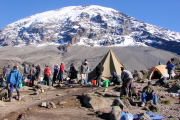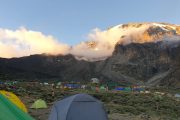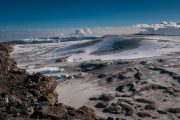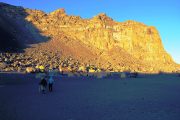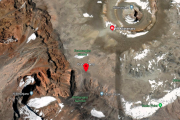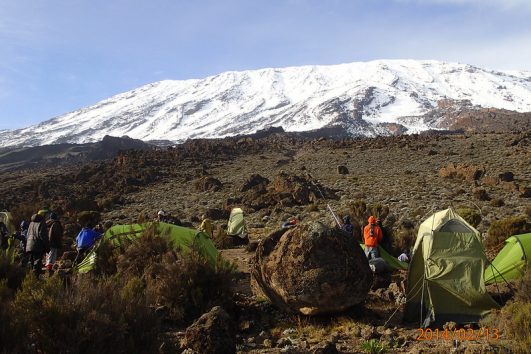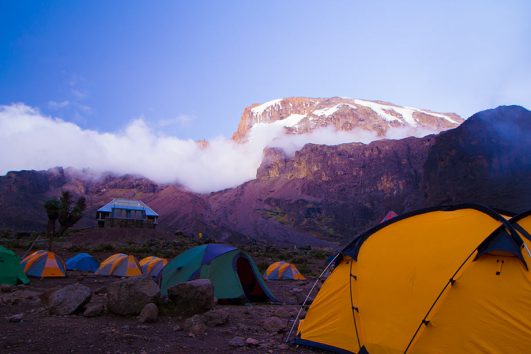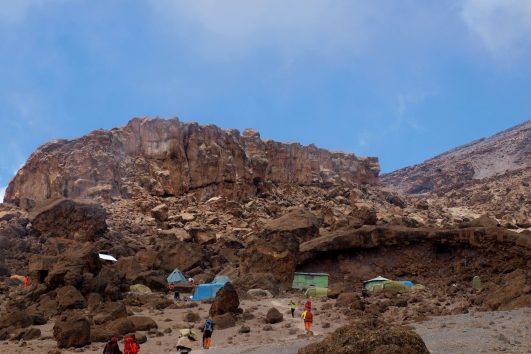Crater Camp Elevation: 5,730 m.a.m.s.l
The Crater Camp at Mount Kilimanjaro’s Kibo should not be confused with the Kibo Huts Camp, the Crater camp at Kibo is just an overnight resting point or campsite with not even a single structure built here. Kibo Crater campsite is open ground without anything, not even a toilet. The main reason why there are no structures here is because of the latitude that this campsite is located.
This camp is located on top of the Kibo volcanic cone otherwise known as the Kibo Peak, the highest peak on Mount Kilimanjaro, meaning building anything here would be a challenge considering the elevation and location at this high point.
Kibo crater campsite lies next to the summit serving as a resting point for climbers about getting to the summit of Mount Kilimanjaro especially hikers using Kilimanjaro’s Western breach route. This campsite is also suitable for climbers who choose to spend a night at the summit.
Even though the extra effort is needed to pitch camp here due to the loose gravel and scree that claims much of this ground, it has a positive side to it. Kibo’s Crater Camp gives you the opportunity to marvel at the beautiful view on top of Mount Kilimanjaro, courtesy of the vast and unreal plateau on top of Africa’s rooftop.
Staying here though means you will be charged extra as it is steeper here, there are no tents available here and of course, this area lacks any water.
Location of Crater Camp on Kilimanjaro
Right at the top of Kibo standing at 5,875 meters, the highest peak on Mount Kilimanjaro lies the Crater Camp at an altitude of 5,730m which is quite close to the summit.
This campsite got its name due to the nearness to the Kibo Crater on the mountain and most of the glaciers of Kilimanjaro.
The area on which the Kibo crater campsite sits is pretty much an alpine desert filled with snow ice and zero plant life and almost zero animals too.
Any of the 7 Mount Kilimanjaro routes lead to this area which experiences very low temperatures below freezing point and very low pressure, making it a no-go zone for anyone experiencing serious altitude sickness.
How high is the Crater Camp located?
5,750 m (18,865 ft) above sea level is how high the Crater Camp is located. The mountain summit, Uhuru Peak stands at 5,895 meters high (19,340 ft). So, before setting up camp, you actually don’t descend very far.
Everest Base Camp, which stands substantially lower at 5,364 m, offers a different height comparison (17,598 ft).
What is the distance from Crater Camp to Uhuru Peak?
Only one kilometer (0.6 miles) separates Crater Camp from Uhuru Peak. The hike from Crater Camp to Uhuru Peak can take up to an hour.
Which route will lead me to the Crater Camp?
We provide transportation to Crater Camp for clients ascending the Lemosho Route or Northern Circuit. For a stay at Crater Camp, good acclimatization is provided by these routes.
What makes Crater Camp unique?
The opportunity to explore the crater throughout the day is Crater Camp’s main draw. Daytime temperatures may be pretty warm, and there are hardly any other people around for you to explore the crater with at your leisure.
Visitors to Kibo Crater can take advantage of getting up close and personal with sights like the ominous Ash Pit and the steep edges of the Furtwangler Glacier, which many people will never get to see. Additionally, the sunrise the following morning will be magnificent and unmatched thanks to a short walk to the crater rim!
Reusch Crater & the Ash Pit can be reached via a two- to three-hour roundtrip hike from Crater Camp for campers who are in good physical condition. One of the best photo opportunities available, without a doubt!
 What to expect when you sleep at Crater Camp
What to expect when you sleep at Crater Camp
Expect a difficult night.
Expect a challenging night for anyone sleeping at Crater Camp. The extreme cold and altitude are the two main difficulties.
A cold and chilly night
In the evening, Kibo Crater’s temperature can quickly fall below -10°C (14°F), occasionally even reaching about -20°C (-4°F). Another possibility is snow. The coldest months, with the greatest chance of snowfall, are December and January. You should be aware that snowfall can make the terrain difficult to see.
We strongly advise reading Best time to climb Kilimanjaro before deciding on a month to climb.
Effects of altitude sickness
The effects of altitude are another factor. Altitude sickness symptoms such as headaches, nausea, dizziness, and shortness of breath, as well as poor sleep, are experienced by everyone staying at Crater Camp. At Crater Camp, headaches are very frequent and can be quite severe.
Who should sleep at Crater Camp?
Those who have already traveled and slept at high altitudes are better suited for a stay at Crater Camp.
These people are more aware of what their bodies are capable of and incapable of. Those who are accustomed to living at high altitudes also benefit.
We don’t think it’s our place to recommend or advise against including a Crater Camp sleepover. Everyone is unique, therefore for some people, the scenery and experience of spending the night in Crater Camp will surpass any inconveniences. Others might be better off avoiding this option because the almost certain headaches, nausea, and insomnia will be too much for them.
However, we won’t just take everyone to Crater Camp. Your trip manager will need to know about your experience with high-altitude trekking, your familiarity with physical discomfort (! ), and your comfort level with taking risks. You’ll need to climb a path that provides for proper acclimatization, therefore your trip manager will also talk to you about which ascent route you’d follow.
So, certainly, we will plan a Crater Camp itinerary for individuals who request it and who we believe are capable of handling its challenges. If you’d like to learn more about Crater Camp, please give us a call; we’d be pleased to talk with you about it without any obligations.
What to see at Crater Camp
The Crater camp is a beautiful place on Mount Kilimanjaro that offers stunning views and equally beautiful features around the crater camp of Kibo, Mount Kilimanjaro.
Ice fields
While the ice fields and lone glaciers on Kilimanjaro’s summit fluctuate with the seasons, the snow does not. However, they are tragically getting smaller; from 1912 to the present, they have lost nearly 80% of their mass.
While the Southern Ice Field is breathtakingly beautiful and accessible to all Kilimanjaro hikers, those who remain at Crater Camp get a closer glimpse at the Northern Ice Field, particularly the Furtwangler Glacier.
The Furtwangler Glacier
One of the most well-known Kilimanjaro glaciers is Furtwangler Glacier. This is due, in part, to its proximity to Uhuru Peak. However, the majority of trekkers never approach it. On the other side, those that travel down to Crater Camp get the pleasure of approaching it directly.
It is impossible to really appreciate Furtwangler’s size from a distance or from above, but you can do so by standing at the base of the mountain. In addition, you can get a close-up look at the patterns that constant exposure to harsh weather and winds has inflicted on its beautiful blue and white splendor.
The Ash Pit
The impressive mountain vent in Reusch Crater is known as “The Ash Pit.” The hole serves as a vivid reminder of Kilimanjaro’s volcanic past and the precipitous descent is an impressive sight.
Additional information
| Routes | Lemosho, Shira, Umbwe and Machame, Western breach, Northern Circuit routes |
|---|---|
| Amenities | Empty Campsite |
| Vegetation | Alpine |

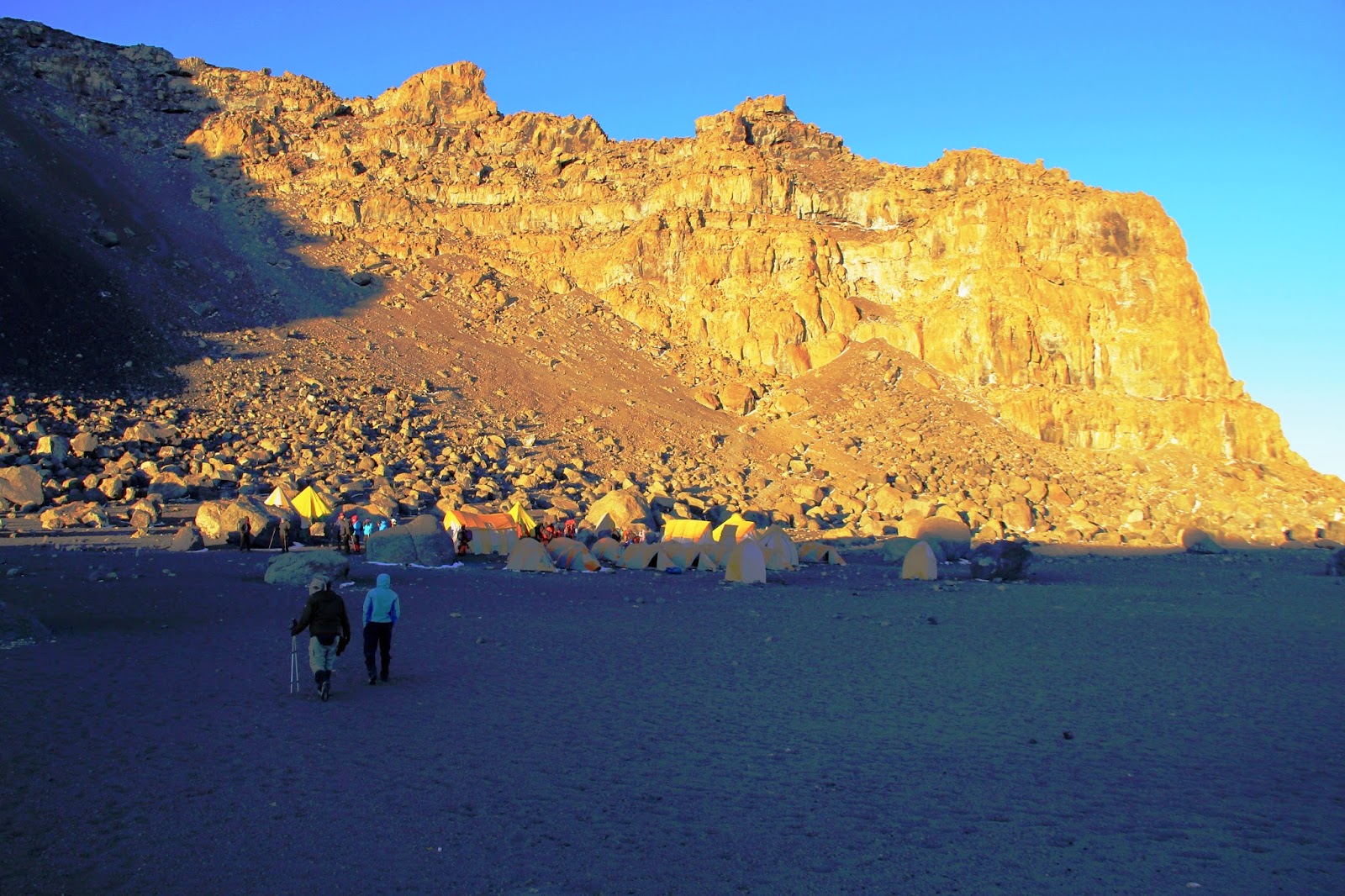
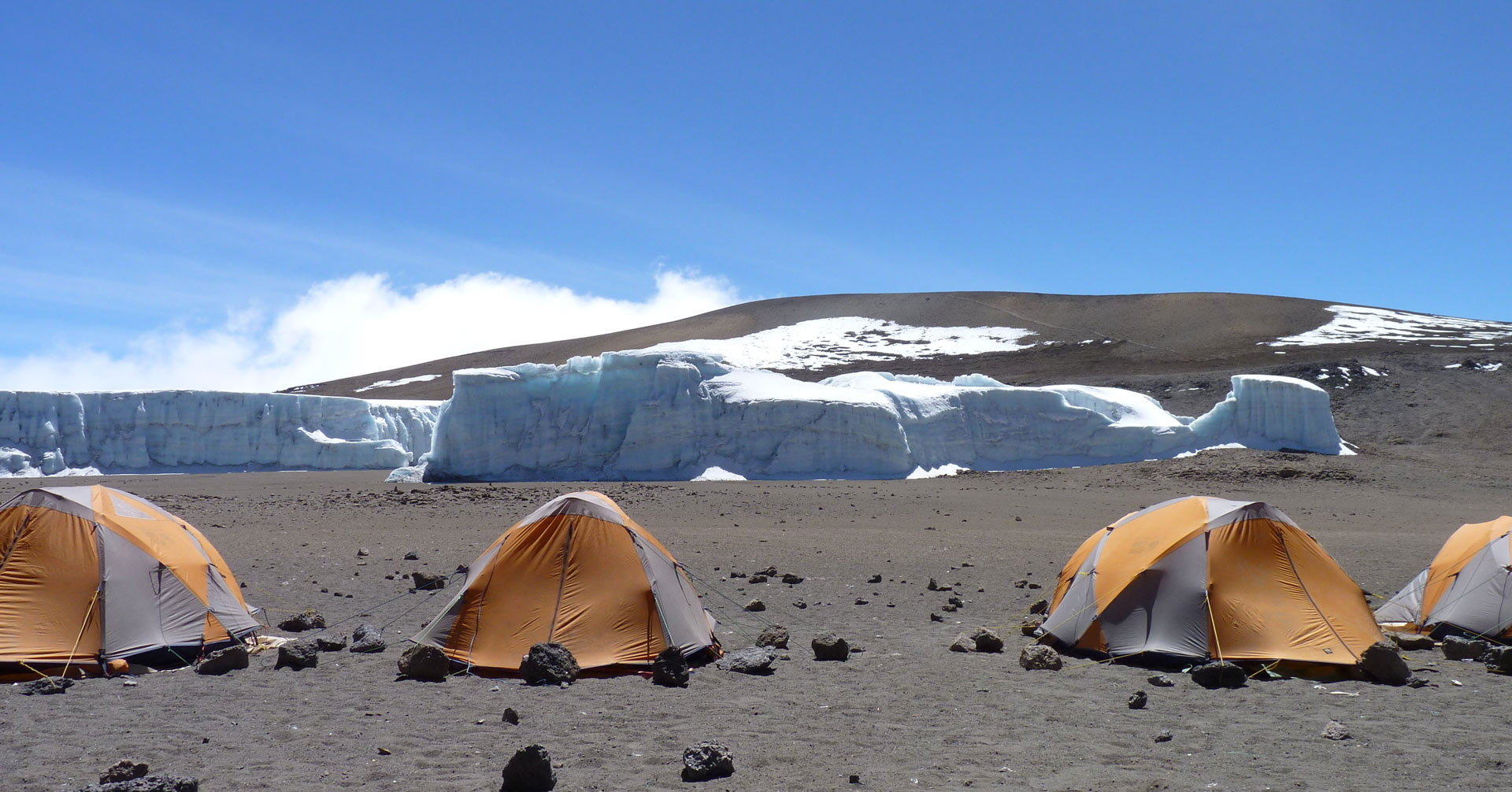 What to expect when you sleep at Crater Camp
What to expect when you sleep at Crater Camp